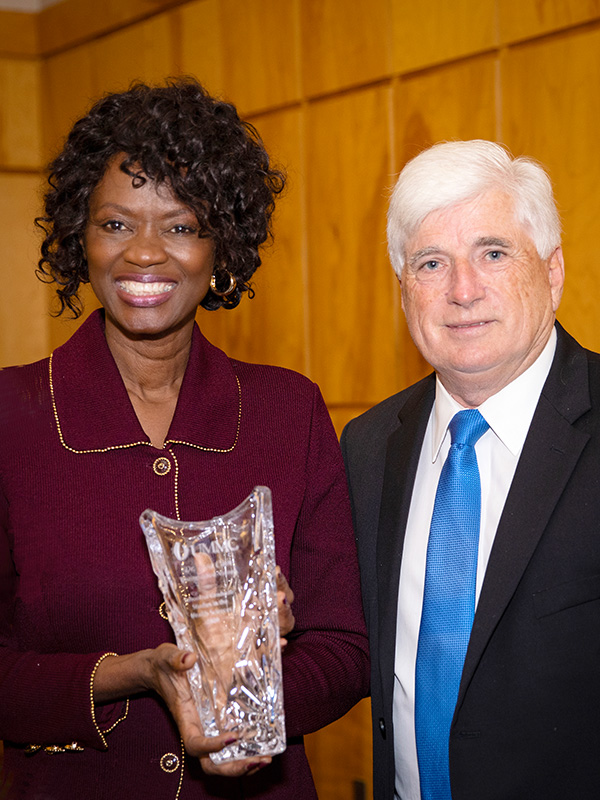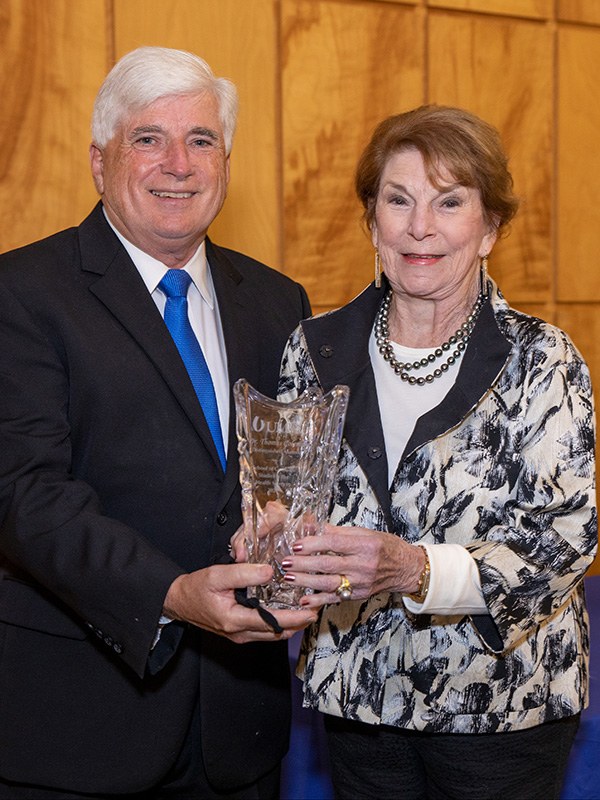SGSHS honors two alumni at Research Day

The School of Graduate Studies in the Health Sciences held its Research Day October 26 in the Norman C. Nelson Student Union.
Dr. Joey Granger, dean of the SGSHS, said he was excited to have the annual event back in place after being postponed last year due to COVID-19.
“It’s good to have everyone together again and highlight the outstanding contributions our students make to the Medical Center’s research mission,” Granger said.

As part of its return, the SGSHS recognized two Distinguished Alumni. Dr. Lisa Cain, 1989 graduate of the anatomy program, received the 2020 award, while the late Dr. Thomas Coleman, a 1968 graduate of the biomedical engineering program, received the 2021 award.
“This is a great opportunity to highlight graduates who’ve gone on to make major impacts in research, education and service,” said Dr. Joey Granger, dean of the SGSHS.
Cain, associate dean for professional development and faculty affairs at the University of Texas Health Sciences Center at Houston School of Dentistry since 2017, spoke at Research Day as the 2020 Distinguished Alum.
A native of Canton and the daughter of a chemistry teacher, Cain studied biology at the Jackson State University Honors College. She joined UMMC’s anatomy PhD program, where she spent her days examining blood vessel cells under a scanning-electron microscope for signs of brain bleeds.
“She clearly had the spark of curiosity and intelligence that can make for a good scientist,” said Dr. Paul May, professor of neurobiology and anatomical sciences, who Cain counts as one of her mentors and advocates during her PhD studies. “I little dreamed how tremendously successful she would be. It gives me so much pleasure to see her success.”
She told the students who now populate the Medical Center’s labs and classrooms that the high point of her “homecoming” was the chance to “bask in your brilliance and your excitement in science.” This included a visit to Research Day’s poster session, where 60 students presented their science and experiments regarding preeclampsia, substance use disorders, high blood sugar, anatomy education and other topics covered by the SGSHS’s eight PhD programs.
“I know it’s not easy for you. I remember the days when I barely watched television,” Cain said.
As a UMMC student, Cain had her sights set on one day winning a Nobel Prize for her work, she said. After graduation, she completed postdoctoral fellowships at Robert Wood Johnson Medical School and the Center for Biotechnology and Medicine in New Jersey focused on spinal cord neuron projection after injury.

“Some of you will spend your life in the laboratory, and some of you may take on a different role,” Cain said. However, “that information and knowledge you gain is not lost, and you learn how to interweave” the talents and experiences you have.
For Cain, her early experiences in research put her on a path to become a nationally and internationally educator, administrator, leadership coach and advocate for students and faculty.
It prepared her to direct University of Texas Medical Branch-Galveston’s Medical Student Summer Research programs, where her leadership introduced more than 600 physicians-in-training to scientific discovery.
It prepared her to be an anatomy teacher for medical and dental students, for which Cain received the University of Texas System Regents’ Outstanding Teaching Award in 2015. The next year, she received UTMB’s Martin Luther King Service Award for her work on programs that strengthen the pipeline of disadvantaged students in science and medicine.
“Do not let anyone tell you that your cultural background, the small town you grew up in, your socioeconomic background, and your educational background,” will dictate what you can achieve, Cain said.
Instead, your character and forward-thinking will set you on the right path, as well as a pen and paper for taking notes.
“Listen to faculty wisdom as well as what’s written in an academic textbook,” Cain said.
A leader in the Association of American Medical Colleges, Cain is chair-elect of the Group on Faculty Affairs, her work supports deans, administrators and educators as they create and conduct policies and development activities.
“Understand the magnitude of your impact as an educator,” Cain encouraged the faculty.
During the question-and-answer session, clinical anatomy PhD student Kathryn Veazey asked Cain for advice on how to best support students from underrepresented minority groups during their training.
In her answer, Cain referenced a line Ralph Ellison’s novel Invisible Man – “I am invisible, understand, simply because people refuse to see me” – and encouraged Veazey and her fellow future educators to “acknowledge the greatness in all people, no matter where they come from,” Cain said. Instead, let students tell you what support they need to meet their goals.

The SGSHS’s 2021 Distinguished Alum, Dr. Tom Coleman, helped hundreds of trainees meet their goals through his unique ability to teach both advanced physiology and mathematics, while making groundbreaking contributions to biomedical research.
In the classroom, “[Coleman] was able to explain complex ideas in a simple manner,” said Granger, a 1983 physiology graduate.
Coleman, a 45-year faculty member in Department of Physiology and Biophysics faculty at UMMC, died February 27. Dr. Peggy Coleman, long-time faculty in the School of Health Related Professions, received the award on behalf of her husband.
Dr. John Hall, Arthur C. Guyton Professor and Chair of Physiology and Biophysics, shared his remembrances of Coleman, including “his greatness as a scientist and as a person,” who was “really the leader in bringing together mathematics and experimental work.”
After growing up and studying in Rochester, New York, Coleman headed south to earn an MS in electrical engineering at Mississippi State University and enrolled in that school’s joint biomedical engineering PhD program with the physiology department at UMMC. Here, he started his decades-long scientific collaborations with Dr. Arthur Guyton, then chair of the department, and numerous trainees who became their professional colleagues.
Coleman “laid the groundwork in the field for a whole new concept in hypertension:” Hall said, “that the kidney plays a dominant role in blood pressure regulation.”
Some of Coleman’s contemporaries saw the idea as “revolutionary”, while others maintained skepticism, thinking the heart played a more important role. Today, his work is foundational in understanding the connections between kidney function and not just hypertension, but other forms of cardiovascular disease.
These connective ideas help form the basis of the 1972 Guyton-Coleman model of cardiovascular dynamics, a circuit board of cause and effect that served as a basis for NASA’s Digital Astronaut Project and grown into 10,000-variable model of human health and disease.
“Without exaggeration, the Guyton-Coleman model has likely stimulated more research than any other [in the field],” Hall said.
Coleman had a rare ability to use “elegant analyses to solve elegant problems,” he added, combining biology and engineering through computing and programming languages.
“Tom was a maestro of early computers” and “took on tasks in computing that no one had taken on before,” Hall said, saying that Coleman lived up to the catchphrase on his favorite t-shirt: “technology is no place for wimps.”
Then again, Coleman probably would not have called anyone that.
“He was a kind-hearted, humble person,” Hall said.
After the Distinguished Alum presentations, the SGSHS presented 10 students with awards for their Research Day poster presentations. The winners are:
- Adesanya Akinleye, experimental therapeutics and pharmacology
- Mary Carr, microbiology and immunology
- Shannon Curran, clinical anatomy
- Andrew Ferriby, clinical anatomy
- Sarah Fitzgerald, experimental therapeutics and pharmacology
- Owen Herrock, experimental therapeutics and pharmacology
- John Aaron Howell, neuroscience
- Alexandra Huffman, cell and molecular biology
- Bridget Konadu, cell and molecular biology
- Jacob Pruett, cell and molecular biology


